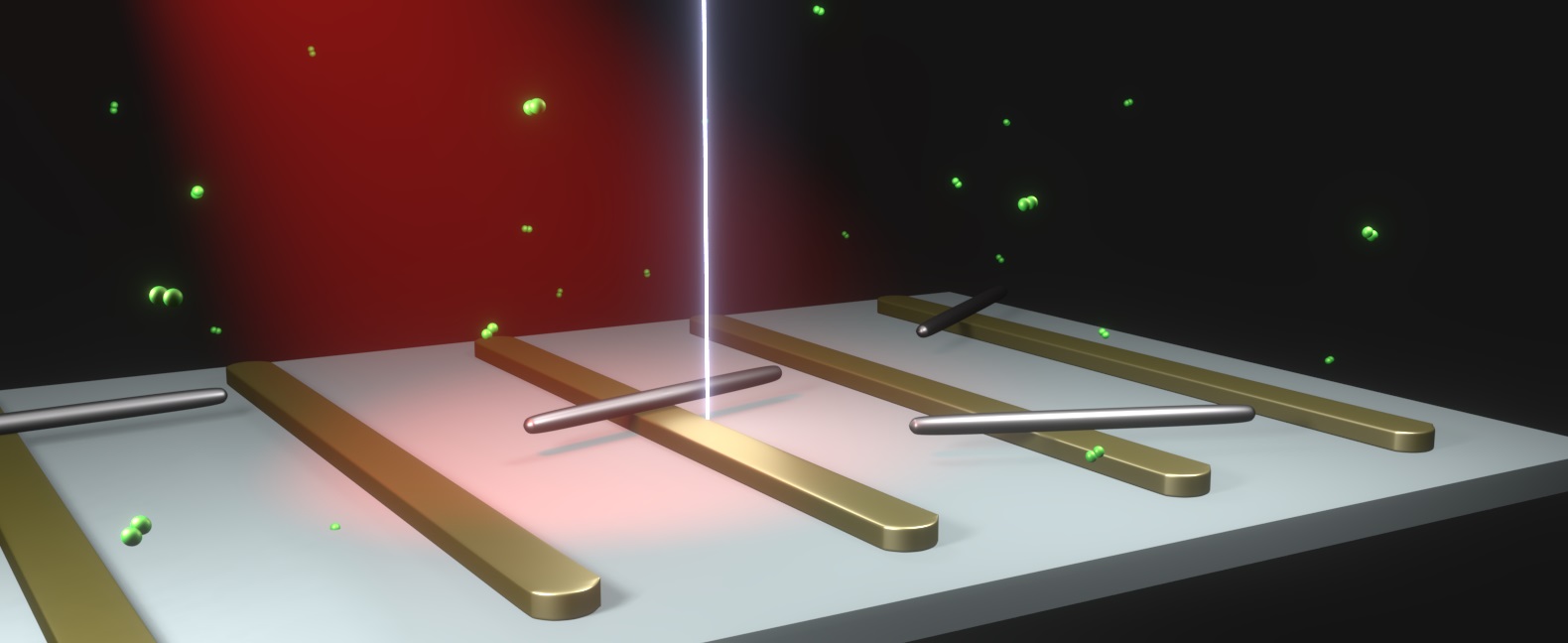STANFORD, Calif., Jan. 18, 2021 — Material scientists at Stanford University have developed a method to exert control over catalysts using light and advanced fabrication and characterization techniques. The work could be an early step toward more efficient catalysts, new forms of catalytic transformations, and, potentially, catalysts capable of sustaining more than one reaction at the same time.
A proof-of-concept experiment used rods of palladium approximately 1/200th the width of a human hair as catalysts, placed above gold nanobars that focused and “sculpted” the light around the catalyst. That sculpted light changed the regions on the nanorods where chemical reactions releasing hydrogen occurred.

Palladium nanorods lie atop gold nanobars. An electron beam is directed at the sample to watch the catalytic interactions between the hydrogen molecules (in green) and the palladium catalyst. The light driving the illumination is shown in red. Courtesy of Katherine Sytwu.
“This research is an important step in realizing catalysts that are optimized from the atomic scale to the reactor scale,” said Jennifer Dionne, associate professor of materials science and engineering and senior author of the paper. “The aim is to understand how, with the appropriate shape and composition, we can maximize the reactive area of the catalyst and control which reactions are occurring.”
To observe the reaction, the researchers needed a powerful microscope capable of imaging an active chemical process at an extremely small scale.
“It's difficult to observe how catalysts change under reaction conditions because the nanoparticles are extremely small,” said Katherine Sytwu, a former graduate student in Dionne’s lab and lead author of the paper. “The atomic-scale features of a catalyst generally dictate where a transformation happens, and so it’s crucial to distinguish what’s happening within the small nanoparticle.”
The microscope also needed to maintain compatibility with the introduction of gas and light into the sample.
The researchers ultimately used an environmental transmission electron microscope at the Stanford Nano-Shared Facilities with a special attachment, previously developed by the Dionne lab, to introduce light and make visual observations at a near-atomic level.
When met with certain temperature and pressure conditions, hydrogen-rich palladium releases its hydrogen atoms. To see how light might affect this process, the researchers customized a gold nanobar to sit below the palladium and act as an antenna, collecting the incoming light and funneling to the catalyst.
“First we needed to understand how these materials transform naturally. Then, we started to think about how we could modify and actually control how these nanoparticles change,” Sytwu said.
Without the light, the most reactive points of dehydrogenation are the two tips of the nanorod. The reaction then resonates through the nanorod, expelling the hydrogen as the reaction moves. When light is introduced, the reaction could be manipulated to travel from the middle outward or from one tip to the other. Depending on the location of the gold nanobar and the illumination conditions, the researchers managed to produce a variety of alternative hot spots.
The work opens up the possibility of increasing the efficiency at the single catalyst level. One catalyst could do the job of many, with the introduction of light powering numerous reactions across the surface, or, potentially, increasing the number of reaction sites. Light control could also help scientists avoid unwanted reactions that can occur alongside the intended reactions.
Dionne hopes to eventually develop catalysts capable of breaking down plastic at a molecular level to its source material for recycling.
The research was published in Science (www.doi.org/10.1126/science.abd2847).
"light" - Google News
January 18, 2021 at 07:00PM
https://ift.tt/2XRigQz
Sculpted Light Controls Chemical Catalysts - Photonics.com
"light" - Google News
https://ift.tt/2Wm8QLw
https://ift.tt/2Stbv5k
Bagikan Berita Ini















0 Response to "Sculpted Light Controls Chemical Catalysts - Photonics.com"
Post a Comment